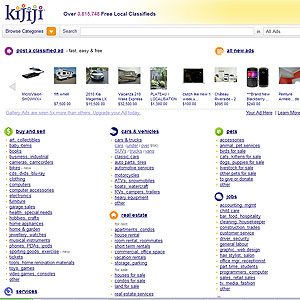
Selling Online Tip #1: Know What It’s Worth
First of all, the adage: “One man’s trash is another’s treasure,” isn’t always true. Damaged, stained, broken, and otherwise “as-is” items generally don’t turn heads unless they are unique, or valuable for repair parts (for example, vintage cameras a hobbyist can collect – or cannibalize for out-of-production parts). In doubt? Check online to see if there’s demand for your item. eBay Canada, for instance, has useful buyers’ and sellers’ guides that provide some indication.

Selling Online Tip #2: Flex Your Social Networking Muscle
Work your social network to quickly unload that Wii you no longer break a sweat to, or that barely used IKEA console table. Some sites, like Oodle.com allow you to target your pitch to Friends only, or everyone (the latter allows your listing to be seen by potential buyers in your vicinity, even if they are not part of your Friend network.)
Pro:
• Also, post your listing on Facebook. Chances are your taste in fashion, furniture, gadgets, and/or entertainment items overlaps with those of your friends, colleagues or neighbours.
Con:
• Smaller audience than online classified and auction sites.

Selling Online Tip #3: Use Online Classifieds for Fast Sales
Classifieds sites like Craigslist and Kijiji are free and easy: basically version 2.0 of the buy-and-sell listings used by newspapers.
Classified sites are best for moving items expeditiously. You may not get the highest possible price for your item, but sometimes that’s not the top priority. Use Craigslist and/or Kijiji when you want to sell that barely-worn designer parka ASAP.
Or, to unload unwieldy furniture and appliances like an old washer-dryer set before the new duo you bought arrives. List the set as a free item, and you could have a savvy freecycler there within hours to take it off your hands – minus the disposal fee the appliance store would charge.
Pro: Your privacy is protected until you respond to a query, since buyer emails are forwarded by the classified site.
Con: Even if you post detailed product info and well-lit photos, be prepared for questions, questions, questions, and potential headaches around meeting times/places, last-minute price-haggling etc.

Selling Online Tip #4: Consider Online Auctions for Bigger Investments
If you’re willing to invest time and money to get the best possible price for your junk, consider setting up an eBay Canada shop. Online auction sites are best if you have a large or ongoing roster of items to sell, and have the time to take lots of photos/monitor auctions/manage payment and mail outs.
If you have plenty of one type of junk – hundreds of books, say, or an attic full of antiques – you could focus your online auction activity there, and use online classifieds for other random items.
Pro: Widest audience reach.
Con: Online auction sites take a percentage of every sale.

Selling Online Tip #5: Try Crafting or Repackaging
If your clutter consists of trendy items like vintage house wares, accessories, or even handmade, vintage, or otherwise collectible craft supplies like fabric, decorative paper goods, beads, buttons, and other ephemera, consider Etsy.
Known primarily as a marketplace for handmade goods, the site also sells used goods in keeping with its homespun DIY aesthetic. It’s the best place to list that circa-1950s teapot, or Grandma’s old rec-room bark cloth drapery. If you’ve kicked your own crafting bug, consider bundling good-condition craft supplies into sampler packs that other crafters will be happy to pick up for a song.

Selling Online Tip #6: Remember These Online Selling “Do”s
• Do your research. Know the market value of items, and be honest about their provenance. Just because you list your grandparents’ late-1970s dinette chairs as “midcentury-modern Eames chairs,” doesn’t make that true. Better to be honest and unload the set for $100 than create a bogus $1000 listing no one takes seriously.
• Do meet in a public place for personal transactions. When that’s not possible, protect your safety by scheduling the meeting when other adults will be with you.
• Do take great photos: overall images, different angles, close ups, ensuring all are well lit. Try to include scale: use a model for clothing (shoot below the face, to protect privacy), or shoot a table within the context of a living space.
• Do consider niche sites for selling niche products, including a cult-following used car, old wedding gown or prom dress, or comic book collection. Chances are, if people are discussing it online in a fan site, there’s an attendant re-sale site.
(Photo courtesy of Bonafide_vintage, ebay.ca)

Selling Online Tip #7: Avoid These Online Selling “Don’t”s
• Don’t confuse an item’s sentimental value with fair market value. Check online for comparables. For example, an on-trend or classic wedding dress may be worth hundreds or even thousands, but an out-of-style model – regardless of original cost – nada.
• Don’t take down an online classified or Facebook Marketplace listing until you’ve closed the sale (that means cash in hand). You could lose sales opportunities before a potential buyer admits they’ve changed their mind.
• Don’t take things personally or be easily offended. If someone low-balls you, or uses criticism as a means of haggling over price, make the decision to either A/ignore or B/negotiate.
• Don’t accept checks. Even checks marked as certified can be too risky, so stick to credit card or PayPal payments for online sales, or, if you’re meeting in person, cash.